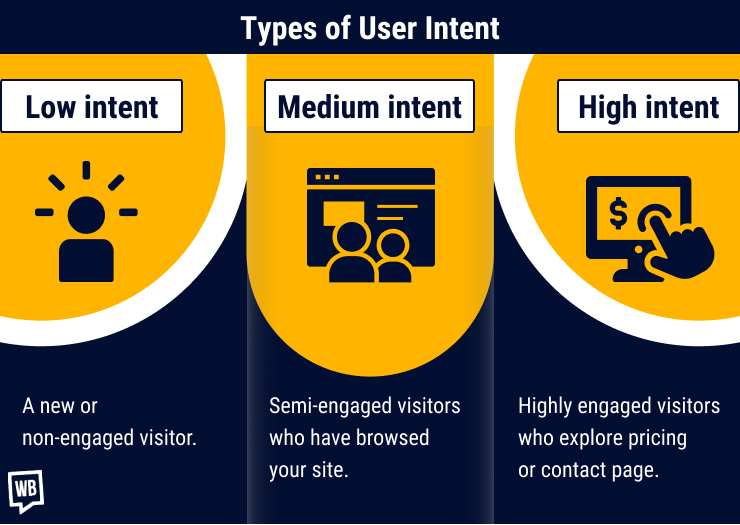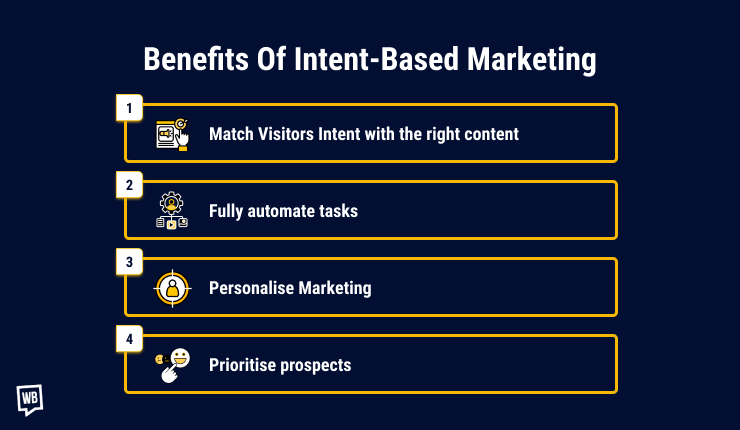“Intent-based marketing” empowers companies to connect with clients in a hyper-personalised manner. B2B marketing space is becoming competitive day by day. It has become crucial to target the right prospects at the right time.
Many marketers still struggle with the question, “what does the prospect needs?”
Intent-based marketing helps you in getting an answer to this question. It uses intent data to filter out the actionable leads with high buying intent. B2B businesses save time and generate higher ROIs by integrating intent-based marketing with their brand advertising strategies.
But what exactly is intent-based marketing?
In this article, I answer all your questions about intent marketing and intent data, so you are all set to include it in your next marketing campaign.
What is Intent-Based Marketing?
Intent basically means a reason why somebody is visiting your website.
Intent-based marketing is the process of understanding the purpose behind a prospect’s online behavior. In intent marketing, such tracking is not limited to just your site but expands to third-party websites.
For example, say you have a SaaS for lead generation. If one of your target prospects starts researching your competitors, such as ActiveCampaign, intent data will notify you. With this data, you can recognise any particular need of that prospect and run a more targeted advertisement. Like your ads could have a title like, “Faster and Better Than ActiveCampaign”, which will make the audience inclined to check your brand out.
Here is an important metric from Google
According to YouTube data, campaigns that use intent-based targeting on mobile devices have a 50% higher brand awareness than campaigns that only use demographic targeting.

Intent data and intent-based marketing allow you to connect with your buyers’ personas by addressing their actual demands. Depending on the intent of your leads, you can customise your marketing and nurturing initiatives for better CTR.
Types of User Intent
As a marketer, you can judge a user’s intent when looking at a lead.

Let’s give them some names.
- Low intent: Is the person who hasn’t spent much time on your site and hasn’t engaged much with your content. It means that there’s a lot of potentials for them to become a customer or client!
- Medium intent: Visitors are just a little more interested than your typical visitor, and they’ve spent some time browsing your site. They’ve also downloaded a couple of things and engaged with some posts.
- High intent: Visitors spend a long time on the website. They also visit the pricing or contact page. These signals show that these visitors are very far in the buyer’s journey, and they’re considering a purchase decision, such as visiting the pricing or contact page.
These different levels of intent map to the stages in the funnel. (ToFu, MoFu, BoFu)
Check out this blog to know more about:
- Top Of Funnel Marketing: Examples and Strategies
- How to Nurture Leads With Middle of the Funnel Lead Generation
- Proven Strategies For Nurturing Bottom of The Funnel Leads
Understanding B2B Intent-Based Marketing
How can you measure intent in a b2b setting, where sales cycles are long, and many players are involved?
Well, in this case, the intent is a combination of three things:
- Topic: When visitors visit your website, they have a particular problem or interest in mind. Their topic of interest is a sign of what they are looking for.
- Context: Context gives meaning to why somebody is visiting your website. Let’s say a lead could be researching a topic or looking to buy. Based on a prospect’s job title or position, we can determine the context of the visit, whether such users are a buyer or an influencer.
- Surge Data: In B2B marketing, we use surge data to understand intent. You can get buying signals or surge alerts when a particular business or account you are interested in has shown intent.
With intent, you’ll be able to track people’s interests, and intentions. It means you can send them the right message at the right time, based on their online activity, so they get what they are looking for, and you get your sales.
What is Buyer Intent Data?

Let’s talk about the elephant in the room. “B2B buyer intent data”
B2B buyer intent data is an aggregated dataset that captures intent signals and signals which companies are active in the buying cycle.
When a potential brand visits or interacts with content related to your product/ service/ industry topics on multiple websites and social media, it sends a clear buying signal captured by companies like Bombora.
Bombora is a third-party intent data provider that collects massive demographic or firmographic data from multiple sources, continuously monitoring the consumption of over 7,000 business topics to identify intent signals. They call themselves a “Data Co-operative.”
Bombora isn’t the only third-party intent data vendor on the block. Several other companies offer comparable solutions, including 6Sense, ZoomInfo, and TechTarget’s Priority Engine. Each vendor has its unique differentiators and proprietary analytics tools.
Here are some examples of external intent data:
- Increased interest in social pages, articles, posts, etc., in a particular segment from sources you do not own.
- Export of gated content from the niche communities
- Engagement on ads in a similar category related to yours
How To Capture Intent Data?
How visitors consume your data gives out strong signals of their buyer intent. Depending on the type of content the target audience is consuming can give you an insight into what your target audience is searching for.
You can access these signals through your marketing stack or third-party systems.
Intent data can come from your sources. For example, using Google Analytics, you can determine:
- Time spent on-page
- Conversion metrics
- Engagement metrics
- Clicks on a social media ad
With other third-party tools like LeadFeeder, you can get insights when a particular company’s employees visit your website.
Other signals could include:
- Email newsletter subscriber behaviour
- Interactive content consumed
- Reverse IP Lookup
Utilising Intent Data for Account-Based Marketing
Account-based marketing (ABM) is a targeted marketing strategy that creates personalised campaigns and relevant content for specific accounts rather than a broad audience. It involves identifying key accounts and purchase intentions within the consumer profiles and then tailoring marketing efforts to meet the specific needs and interests of those individuals.
By focusing on a smaller set of high-value accounts, ABM aims to create deeper relationships with decision-makers and increase the likelihood of closing deals.
Leveraging intent data in account-based marketing can be incredibly impactful. Just imagine having access to precise information regarding the topics your target accounts are researching, such as their exact pain points and requirements.
With such information, you can design highly targeted marketing campaigns directly relevant to a high-potential prospect’s current research questions. It significantly increases the likelihood of generating B2B leads and converting them, as opposed to using general, non-specific messages.
Moreover, by utilising intent data, you can gain valuable insights into the business challenges that your target personas are facing. When reaching out to them, your effective marketing campaigns can immediately solve these challenges during the initial touchpoints and later build on them for the final conversion. This can be a game-changer for your business.
Benefits Of Intent-Based Marketing

Let’s talk about some of the benefits of successful intent-based marketing:
1. Match Visitor’s Intent with the right content
You can understand how prospects react to your brand messaging with clever tracking. You can then optimise the communication and create targeted campaigns based on the stage your prospects are in. Even if it doesn’t lead to a purchase, this approach will trigger a positive user experience and stronger brand association.
2. Visitor Intent and marketing automation
With the help of marketing automation tools like ActiveCampaign, Plezi, and Salesforce Pardot, you can fully automate tasks like sending out emails depending on user intent. It means your team spends less time on repetitive tasks to focus on other tasks.
3. Personalise Marketing
Recommender engines like https://www.recombee.com/ can use AI and intent to make recommendations and, therefore, drive a prospect to complete the journey faster.
4. Prioritise prospects
Using intent and scoring models, it is possible to prioritise prospects through the entire customer journey. Marketers can now focus on the most promising prospects and hand them over to the sales team to close the deal.
Lead Scoring Vs Intent-Based Scoring
Lead scoring is a great way to check if the prospect matches your target audience. e.g. things like company size, job title, industry, no. of employees, and location are great, but they do not signal whether these prospects have intent to buy.
With intent data and signals, you can build an accurate scoring system.
In tools like ActiveCampaign, you can score when visitors visit web pages or click specific links in an email. And with intent data, you can take your b2b marketing to a different level.
Future of Intent-Based Marketing
Technological advances, such as machine learning and artificial intelligence, has made it easier to collect and analyse data about online user behaviour, which can be used to identify intent. For example, ChatGPT has been making waves these days.
By using an intent-based marketing strategy, companies can create highly targeted campaigns that are more likely to resonate with potential buyers. Taking personalisation one step further, companies can use intent data to understand exactly what target prospects are looking for and tailor their marketing messages to meet those needs.
Another area where intent-based marketing is likely to grow is in the use of conversational AI and chatbots. By understanding the intent behind a customer’s message, chatbots can provide personalised and relevant responses, increasing the likelihood of a successful engagement.
Your lead nurturing, email marketing, and all other types of marketing efforts can get impacted positively with the help of intent-based targeting.
Overall, intent-based marketing will continue to evolve and become an increasingly essential part of the marketing landscape. As more companies realise the value of personalised, targeted marketing, intent-based marketing will become a key tool in their arsenal.
Conclusion
Intent-based marketing is a powerful tool to boost your lead generation and nurturing efforts. By utilising intent data correctly, you can capture quality leads and turn them into life-long customers. Intent marketing helps you plan a sales funnel that is dynamic and in tune with the requirements of your buyers’ personas.
If new B2B marketing tactics like intent-based marketing approach excites you. In that case, you can check out my marketing automation blog, which can assist you in increasing your sales and marketing efficiency.
Also, Check:
Appointment Booking Funnel: Guide To Build An Automated Funnel
B2B Startup Marketing Guide: Key Elements and Strategies
How to Improve B2B Website Conversions: Effective Strategies

%20(1).webp)